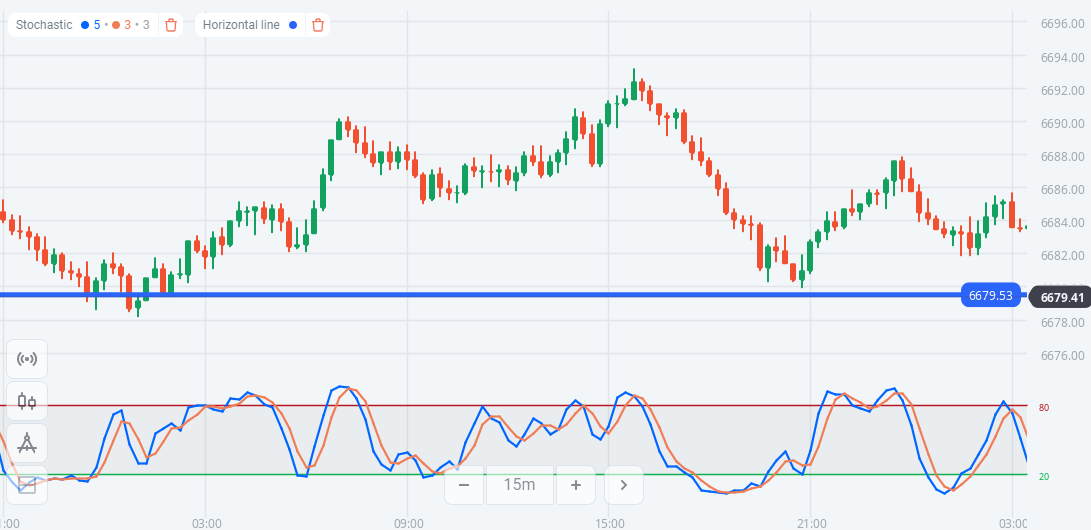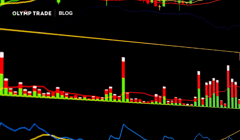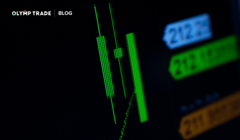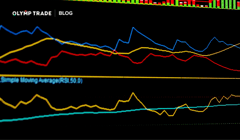
Before jumping into Part 2 of the best fixed time trading strategies for beginners, let’s recap that fixed time trading (FTT) is a type of trading where assets are traded within a fixed time range. There are certain strategies that have been developed to help beginner traders determine market trends and price action. On Olymp Trade, five of these strategies are available regardless of experience or skill level — all you need to do is log in and access them. If you’re hungry for more strategies, simply trade your way through Trader’s Way to level up from Starter to Advanced or Expert.
More details about these concepts and the two first FTT strategies in this series can be found here.
Now, let’s dive into the last three strategies!
Contents:
Interact with the underlined words and green dots to get additional details and explanations.
Additional context for the visuals.
Explanations and definitions of terms.
Reflection
Reflection uses the Stochastic oscillator with Japanese candlesticks and price levels, such as support and resistance. This strategy is recommended for counter-trends, so it is recommended to have some knowledge of market trends before using this strategy.
We recommend using Reflection within five-minute and one-hour timeframes. The duration of the trade should be five times higher than the chosen timeframe. For example, if you are working within a 10-minute timeframe, the period of the trade should be 50 minutes.
When setting up the strategy, first you will need to draw support and resistance levels on the chart. You can use the horizontal line tool to do this.
Read more: Support and resistance levels: How to set and use them
A sell signal occurs when the price hits a resistance level and a correction starts in the chart. At the same time, the Stochastic oscillator should be crossing its signal line and its overbought line from top to bottom. In this case, the overbought line is at the stochastic level of 80. You will also need to find price action reversal patterns to generate a better buy signal.
The opposite is needed for a buy signal: The price needs to hit a support level, starting a correction from there. Simultaneously, the Stochastic oscillator should cross its signal line and its oversold line (20) from bottom to top, as well as price action patterns in the chart, to confirm the quality of the trade signal.

Signal up.
Read more: Basic candlestick patterns
Relative Strength Law
The Relative Strength Law is based on a fast, five-period RSI oscillator. As well as the previous strategy, it is a counter-trend strategy and can be used in timeframes ranging from five minutes to one hour.
The Relative Strength Law works faster than the Reflection strategy, as it needs only a small correction during a main trend, while Reflection expects a bigger correction, which can sometimes change the direction of the current trend.
Therefore, trades with the Relative Strength Law strategy should last twice as long as the timeframe used. So, if you are analyzing the 10-minute timeframe, your trade should last 20 minutes.
The signal to open a buy trade occurs when the RSI crosses its oversold line (30) from bottom to top and, at the same time, you recognize a price action reversal (or correction) pattern on the price chart.
To open a sell trade, the RSI must cross its overbought line (70) from top to bottom while there is a price action pattern on the chart.

Sell signal.
Buy signal.
Sliding on Averages
Many declare that Sliding on Averages is the easiest strategy to begin with. The main reason is because of the indicators used: just two simple moving averages! In addition, this trend strategy is different from the previous two presented here, meaning that it’s less risky.
The periods of the simple moving averages used in this strategy are 4 and 60.
The recommended timeframes for this strategy range from five minutes to one hour. The duration of the trade should be two times higher than the timeframe used. For example, if you are trading within a 10-minute timeframe, your trade with this strategy should last 20 minutes.
The signal to trade Down (or open a sell trade) occurs when the SMA-4 crosses the SMA-60 from top to bottom. Please note that this is a trend strategy, so the prices should cross the SMA-60 (often used as dynamic support) from top to bottom. This is not mandatory, but will increase the likelihood of turning a profit.
For a buy trade, the needed signal is a crossing from the bottom to the top of the SMA-4 over the SMA-60, with the price’s uptrend surpassing the SMA-60 resistance.

Sell signal.
Сonclusion
The five strategies outlined in this series each have their own strengths and can be used under different market conditions. Professional traders should know at least some trend and counter-trend strategies so that they can take advantage of any scenario. Those looking to expand their knowledge on taking advantage of market conditions, we recommend checking out our articles on the basics of trendline strategy as well as a clear run-down of what volatility is and how you can still profit in a volatile market. If you’d rather delve deeper and figure out what the best fixed time trading strategy is for you, try our free webinar course on fixed time trading.
On our YouTube channel, there’s even more information about the strategies in this series and much more. Don’t hesitate to subscribe so you can learn how to become a successful trader. Enjoy the wealth of free educational resources here on the Olymp Trade Blog so you can reach your financial goals and take control of your future.
Go to Olymp TradeRisk warning: The contents of this article do not constitute investment advice, and you bear sole responsibility for your trading activity and/or trading results.
A price zone that always sits below the current price level and is where a falling price is likely to get rejected.
A price zone that always sits above the current price level and is where a rising price is likely to get rejected.
The overall direction of a market or an asset’s price.
A price zone that always sits below the current price level and is where a falling price is likely to get rejected.
A price zone that always sits above the current price level and is where a rising price is likely to get rejected.
Refers to the magnitude of change in an asset’s price.











